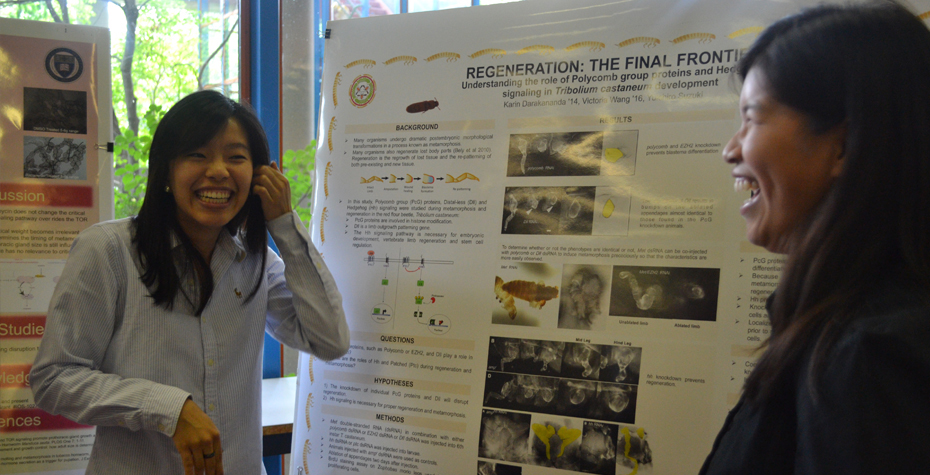A Poster Session Highlights Work and Findings of Student Reearchers

In an afternoon poster session on August 1, Wellesley celebrated the efforts of more than 100 students who participated in this summer’s Science Center Summer Research program.
The Summer Research program provides the opportunity for Wellesley students to work fully-funded in on-campus labs on a variety of projects. Students apply in February; if accepted, they receive a housing and transportation allowance, a summer stipend, and the opportunity to get hands-on experience in scientific research.
This summer, as in summers past, projects ranged in subject matter and discipline. “Some students studied how nanoparticles can be used to treat pancreatic cancer, a cancer with very low rates of survival,” said Yui Suzuki, assistant professor of biological sciences and faculty leader of the biology/psychology/neuroscience disciplinary group. “Students working in another lab investigated the effect of nutritional deprivation on honey bee colony performance to see if pollen availability might be a major cause leading to the colony collapse disorder. Other studies focused on topics such as the role of estrogen in the brain; the ion channels involved in generating a heartbeat; the development of a child's use of hand gestures; the neurons that underlie attention, memory, and vision, the genes that control the development of leaf venation patterns and chloroplast movement; microbes living in different habits and their interactions with each other; and the genetic mechanisms that control limb regeneration.”
Suzuki noted that these were just a handful of the many projects students were working on in various disciplines, including chemistry, physics, mathematics, astronomy, environmental studies, geosciences, and computer science.
Cassie Hoef ’15 (computer science and medieval & Renaissance studies) worked in the Human Computer Interaction Lab on projects like zMol, a 3D molecule builder similar to the plastic molecule kits used in many chemistry classes; zTree, a program that sorts through complex data sets; and zSpace.
“We've been developing 3D software for zSpace, which is a holographic computing machine that allows users to interact with objects as they would in the real world,” she said. “Instead of using a mouse and keyboard as inputs, the machine uses a pen and 3D glasses with polarized lenses. With the pen, you can pick up objects, turn them around, push them deeper into the program, or pull them out of the screen towards you. The glasses allow you to see the object in 3D, but the zSpace also uses motion parallax to track your head movement so you can look around an object in the program as you would a real object.”
“Overall, I have been very impressed with the quality of the students' work and the amount of time they invested into their projects,” said Suzuki. “I think the experience can be challenging at times, especially when experiments don't work, but the summer research experience really gives students exposure to what scientific research is like. I also think that the research experience stimulated a sense of community and collaboration among the students since they worked in a lab together all day long for several weeks and collaborated on projects. It's always wonderful to see students helping each other perform experiments and solve problems.”
Hoef agreed. “Having the opportunity to work on a diverse team with people from many academic backgrounds opened my mind to alternative ways to accomplish the same goal,” she said. “Everyone in the lab is really fun to work with and I think we have a great dynamic... The lab also does a number of fun things together, like going to the movies, out to dinner, or even karaoke!”
